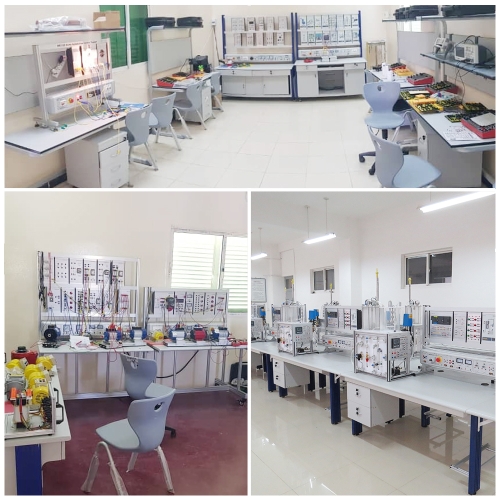1.Description
With the wide application of numerical control technology, the school pays more and more attention to cultivating practical and skilled professionals in production, technical service and other positions, further improving students' practical ability and analyzing problem-solving ability, and comprehensively learning and mastering the control of CNC system. Principle, numerical control programming, electrical design methods and installation, commissioning and maintenance. However, most colleges face the lack of such CNC training equipment. To this end, the company developed the principle of the electronic control system of the CNC milling machine and the internship device for the commissioning and maintenance test bench. The device can enable students to master the control principle of the CNC lathe system, the electrical design method, the selection of components, the electrical installation and commissioning of the lathe, the fault diagnosis and maintenance, the part programming and the graphic simulation processing process, etc., to reach the industrial production site. Internship effect. The main components of the experimental device are industrial control products.
2. the functional requirements
1) This test bench deeply analyzes the GSK980TB2 numerical control system to meet the electrical design of CNC machine tools, the fault design of CNC machine tools, the electrical assembly of CNC machine tools, and the numerical control of machine tools.
2) The test bench adopts a semi-physical lathe to realize mechanical adjustment and installation of the machine tool (including spindle, feed shaft, lead screw, bearing, nut pair, etc.), and meet the electromechanical joint adjustment of CNC machine tools.
3) The lathe adopts a four-station real tool holder for turning machining.
4) The test bench can set 28 common fault points and composite fault points.
5) Each set of encoder, limit switch and machine zero return switch of the test bench is equipped.
6) 1 set of turning tools.
7) The machine tool is equipped with cable and standard interface.
8) The test bench is equipped with a demonstration of a semi-physical lathe, which can process engineering plastics and wooden sticks.
3. the product components
CNC lathe comprehensive experimental platform is composed of wide-numbered GSK980TB2 numerical control system, machine tool electrical control interface board, spindle frequency conversion speed regulation experiment board, four-station automatic tool holder experiment board, three-phase AC stepping drive and stepping motor, input and output module, Low-voltage electrical components and semi-physical lathes.

4. the principle of numerical control
The numerical control console provides a complete control system. The control system has a complete system of GSK980TB2 numerical control technology. The console comprehensively analyzes the control principle and structure of the wide GSK980TB2 system, and electrically connects according to the requirements of real CNC equipment. The CNC machine can be driven to carry out CNC machining. At the same time, the CNC console provides circuit fault system for setting, repairing and evaluating common faults of CNC machine tools inside the control system. The fault system provides a fully open terminal interface, which can set circuit faults. Device failure and internal operating system failure for students to measure and judge. The teacher can set the fault, the student can realize the online measurement and troubleshooting, and can also realize the power-off measurement for troubleshooting, and improve the students' ability to solve the problem.
5. the training platform configuration
1) It consists of a control panel and a training table and a semi-physical lathe. The console is made of iron double-layer matt dense spray structure, aluminum panel; the training table is iron double-layer matt dense spray structure, and the table top is fireproof, waterproof and wear-resistant high-density board. The semi-physical lathe can directly demonstrate machine zero return, machine tool overtravel limit and so on.
2) Three-phase four-wire 380V AC power supply, the leakage protector controls the total power supply, and the power supply of the control panel is controlled by the key switch and the start-stop switch. The voltmeter monitors the grid voltage, and the ammeter monitors the total operating current of the equipment and is provided with indicator lights and fuse protection.
3) CNC system unit: It adopts the wide-number GSK980TB2 system to control two digital control feed axes and one analog spindle.
4) Drive module: The X/Z feed axis uses an AC stepper motor and a stepper drive to form a semi-open loop system.
5) Spindle module: The spindle motor is controlled by frequency converter to realize stepless frequency conversion speed regulation.
6) Tool holder module: Four-position automatic tool holder is used to realize arbitrary knife selection control.
6. the outstanding features of the product:
The company has many years of experience in the production of CNC, so the wide-scale GSK980TB2 CNC system is fully analyzed and displayed on the panel, and the functions of the CNC lathe are all controlled by connectors. The control methods for all control units are as follows:
1) The test bench displays the global map of the general lathe control circuit. The trainee can use this diagram as a demonstration diagram of the design circuit to better understand the control method of the CNC lathe. .
2) Open structure and modular design: The experimental bench decomposes the wide-numbered GSK980TB2 CNC system, expands the control interface to the panel of the test bench, and then uses the terminal block to be connected to each module board for control.
3) Three-phase inverter control unit: Connect to the numerical control system through the patch cord to carry out frequency conversion control, increase the hands-on ability of the trainees, and increase the understanding and analysis of the faults in the control process.
4) Stepper drive control unit: Connect to the CNC system through the patch cord for servo drive control, increase the hands-on ability of the trainees, and let the trainees have a comprehensive understanding and analysis ability for the step controller.
5) the MP unit: connected to the CNC system through the patch cord for manual control of the machine coordinate motion
6) Four-station electric knife holder control unit: Connect to the numerical control system through the patch cord to carry out tool change control, increase the hands-on ability of the trainees, and let the trainees have a more comprehensive understanding of the control process and principle of the automatic tool holder. The test bench also adds a simulation tool holder for reference learning.
7. CNC lathe comprehensive experimental platform training program
1) The following experimental internship projects can be completed through the training platform.
CNC lathe system operation and programming experiment (with semi-physical lathe)
Commissioning operation and fault diagnosis experiment of spindle frequency conversion unit
AC stepper motor operation and fault diagnosis experiment
Design and Analysis Experiment of Electric Control of CNC Lathe
CNC lathe machine zero return experiment
CNC machine tool overrun limit experiment
Parameter setting experiment of numerical control system
Use of input and output signals
Cooling and lighting and fault diagnosis experiment of CNC lathe
Screw pitch error compensation experiment
CNC lathe electronic handwheel experiment
Machine tool RS232 serial communication experiment
Lathe thread processing experiment
28 items of CNC lathe failure design and elimination assessment
2) manual programming and simulation processing training
① CNC lathe programming and simulation processing
a Mastering the structure, format and command system of the NC program;
b understanding of the basic operations of each system;
c Understanding of the basic processing technology of CNC lathes.
② CNC lathe programming and operation training
a Mastering the editing of CNC lathe program
b Mastery of basic operation of CNC lathe
c Skills application of CNC lathe system function
d Fixing and processing of parts in CNC turning
3) understand the common CNC machine tool fault detection and maintenance training
Basic requirements and troubleshooting methods for CNC machine maintenance
Common fault self-diagnosis technology
Common troubleshooting methods
Common faults and handling of CNC machine tools
4) semi-physical lathe parameters:
Semi-physical lathe can directly process workpieces, demonstrate machine tool zero return, machine tool overtravel limit, etc.
The maximum turning diameter of the bed: 250mm
Tool holder maximum turning diameter: 120 mm
Spindle speed range: 30~2000 rpm (inverter stepless speed regulation)
Electric tool holder: 4 stations
Workbench X-axis travel: 130mm
Workbench Z-axis travel: 300mm
Positioning accuracy: 0.02mm
X, Z axis feed speed mm/min: 2000/4000
Main motor power: 750W
Dimensions: 1120 × 590 × 600 mm
8. experimental platform technical parameters:
1) Input power: AC380V (three-phase), 50HZ
2) 28 fault assessments
3) working environment: temperature -200C ± 400 C
4) the whole machine capacity: ≤ 3kVA;
5) Bench size: length × width × height (mm) = 1370 mm × 600 mm × 1890 mm;
6) Semi-physical lathe size: length × width × height (mm) = 1200 mm × 600 mm × 1300 mm;

